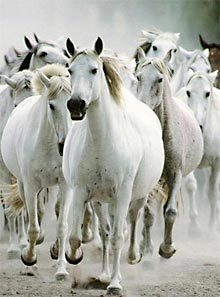
|
 |
 |
 Editorials | Environmental | January 2005 Editorials | Environmental | January 2005  
Live Free and Die
 Judy Blunt Judy Blunt

The overpopulation of wild horses is a serious problem in the West. The Sonora Mexico Wild Horse Repatriation Project seeks to establish a sanctuary in Mexico to sustain 10,000 horses in a natural environment. But projects like this are howled down by animal-rights groups that complain about sterilization and other issues.

 Those whose knowledge of wild horses comes from coffee-table books and animal-rights propaganda tend to embrace the mythology of the wild horse and ignore the reality. The myth is pretty, like artwork: a proud stallion and his mares and their adorable foals gallop through a meadow, mountains in the background, manes and tails streaming. There's a reason people who see that take a photograph or paint a picture. Those whose knowledge of wild horses comes from coffee-table books and animal-rights propaganda tend to embrace the mythology of the wild horse and ignore the reality. The myth is pretty, like artwork: a proud stallion and his mares and their adorable foals gallop through a meadow, mountains in the background, manes and tails streaming. There's a reason people who see that take a photograph or paint a picture.

But here's some artwork from the summer of 2003: A cloud hangs over the Nevada landscape, caused by 500 half-starved horses pounding the high desert to powder, looking for food, stamping any remaining waterholes into dust. The foals are long dead, left behind as they weakened. Cowboys under contract with the Bureau of Land Management set out to gather the horses and move them, but a phone call redirects them to a worse situation in another area.

The overpopulation of wild horses is a serious problem in the West, with herds growing exponentially until they eat themselves out of luck. The land can't support an infinite number of wild horses - which, by the way, are inbred feral descendants of imported domestic horses, hardly more native to the prairie than the cattle their ancestors were trained to herd.

Still, possibly because of our love for the domestic horse, its wild cousins have become cultural icons, symbols of freedom. It's practically un-American to talk about killing them, so we've assumed a sort of willful blindness to both the reality of the problem and its solutions. Animal-advocacy groups rise in indignation over every proposal to reduce the number of wild horses, including sterilization programs, instead demanding a Western version of the miracle of loaves and fishes.

Some 30 years ago, the Wild Free-Roaming Horses and Burros Act provided the land management bureau with two options for horses removed from public lands because of overcrowding: adoption or "humane and cost-efficient" destruction. Ignoring the second option, the bureau has been warehousing 16,000 horses, unlikely to be adopted but ostensibly waiting for new homes, in overcrowded, unsanitary and expensive feedlots. An additional 37,000 horses and burros overgraze land meant to sustain 27,000.

To get the land management bureau to come to grips with the problem, Senator Conrad Burns, Republican of Montana, added a provision to a spending bill last year that allows certain horses to be auctioned off to the highest bidder, which may be a slaughterhouse. Senator Burns's amendment, signed last month by President Bush, may actually end up rescuing the wild horses he is accused of murdering. At its worst, this measure will sacrifice the unadoptable few to the benefit of all. At its best, it will prod us, as a nation, to take that first difficult step toward a sustainable program to manage wild horses.

Adoption is a partial solution, but it's not the whole answer. Adoptions don't keep up with herd growth, for one thing. And not all horses are created equal, for another. People adopt beautiful, young horses. The old, plain and ugly are doomed from the outset. In addition, virtually anyone with $125 can adopt a wild horse, but not everyone has the knowledge and perseverance to tame it, or even, as it turns out, to catch it after it's been let out to graze in its new home.

Horse trainers like Merle Edsall see the worst of the adoption cases when they're called to recapture adult horses whose heads have grown around halters put on them as colts. Too many, he says, spend their days in small pens because their owners, unwilling to put them down, are at a loss for what to do with them. His solution is the Sonora Wild Horse Repatriation Project, which seeks to establish a sanctuary in Mexico to sustain 10,000 horses in a natural environment. But projects like this are howled down by animal-rights groups that complain about sterilization and other issues while ignoring the good such a project would bring.

People who truly love horses need to do their own research. We need places that will accept returned adoptees and horses that no one wants to adopt. The Sonora project, and several other sanctuary plans like it, would provide a place for wild horses to live out their lives in freedom.

Game are controlled through hunting and predation; cattle graze under strict regulations. Only the wild horse is allowed to multiply unchecked, and with catastrophic results. Sanctuaries would keep healthy horses out of costly, unsanitary feedlots, while sending older, unadoptable horses to slaughter would give their herds a better chance at survival. A side effect would be the rejuvenation of our depleted public lands to the benefit of all species. Americans have a chance now to become part of a sustainable solution before we stand guilty of loving our wild horses to death.

Judy Blunt, a professor of creative writing at the University of Montana, is the author of "Breaking Clean." | 
 | |
 |



